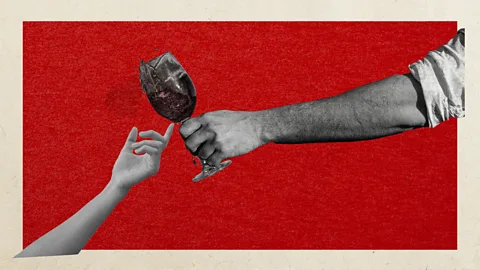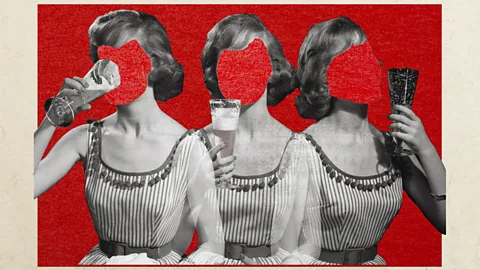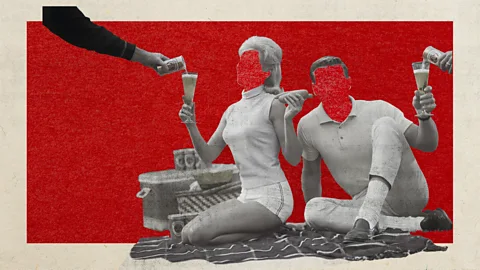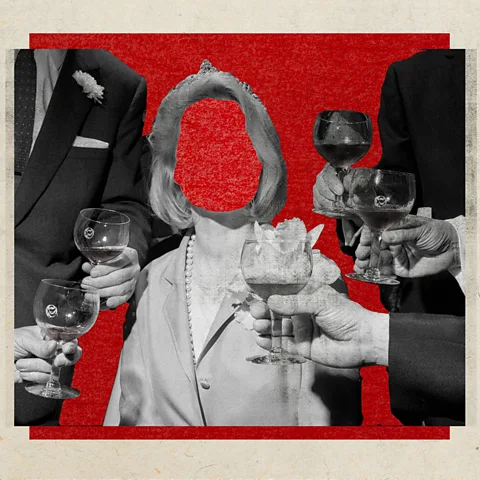Why alcohol is so dangerous for young adults' brains
 Javier Hirschfeld/BBC/Getty Images
Javier Hirschfeld/BBC/Getty ImagesFrom the myth of Europeans' "healthy drinking culture" to the surprising harm of some common family traditions, science is overturning old beliefs around alcohol and young people.
I turned 18 the day before I left home for university, conveniently passing the UK's age threshold for buying alcohol just in time to explore student pubs and bars. When I signed up with a doctor near my new home, she asked how many units of alcohol I drank each week – a common way to measure alcohol intake here in the UK, with 1.5 units roughly equalling a small glass of wine. "Around seven," I said, quickly totting up the few covert vodkas-and-orange that I'd enjoyed on nights out with my friends from school. I thought this was low, but I'd never been much of a rule-breaker.
"That's going to rise now you're here," the doctor replied with a dry chuckle. She wasn't wrong. Within a few weeks, I was happily knocking back a bottle of wine before lining up shots in the student bar. I knew heavy drinking could wreak its toll across the lifespan, but I hadn't considered that my youth would bring additional dangers, compared to someone of 30, 40 or 50. Surely the risks were the same for all adults?
If I'd heard what I now know about the unique ways that alcohol can affect the young adult brain, I might have been a bit more cautious. At 18, my brain was still metamorphosing, and would not reach maturity for at least seven years. This alters the way we respond to alcohol – and drinking during this critical period can have long-term consequences for our cognitive development.
Speaking to researchers about the impact of alcohol on young people, I was surprised by many other findings besides these. Research from around the world is beginning to overturn a range of common assumptions around age and alcohol, such as the idea that continental Europeans have a healthier drinking culture than the UK or US, and that allowing young people to drink at home with meals teaches them responsible alcohol use. Whether or not this new science should change our current drinking laws is a complex political issue, but greater awareness of the facts may at least allow future generations to make a more informed choice about the ways that they choose to party – and might help parents decide how to handle alcohol in their own home.
Small bodies, big brains
Let's be clear: alcohol is a toxin. Its dangers span fatal accidents, liver disease, and many kinds of cancer. Even small quantities can be carcinogenic, leading the World Health Organization to declare that "when it comes to alcohol consumption, there is no safe amount that does not affect health".
Few activities are completely risk-free, though, and the dangers tend to be weighed against the pleasures that alcohol can bring. Our health policies are therefore guided by the principle of damage limitation with moderate drinking. In the US this is defined as having no more than two drinks a day for men, and no more than one drink a day for women – with many other countries offering similar guidance. Although beer and wine are commonly seen as safer drinks, as the US guidance states, the type of drink is not the important factor – instead, it's the amount of alcohol consumed: "One 12-ounce beer has about the same amount of alcohol as one five-ounce glass of wine or 1.5-ounce shot of liquor." Legislation around the age of purchasing alcohol follows a similar logic of damage limitation: the laws protect children, while allowing young adults to make their own choices. In most European nations, the minimum age is 18 years – in the US it is 21.
There are, however, numerous reasons why alcohol may be more dangerous for younger people, even after they have passed the legal minimum drinking age. One is body size and shape: teenagers don't reach their adult height until 21, and even after they have stopped growing vertically, they may lack the bulk of someone in their 30s or 40s. "Drinking one glass of alcohol therefore results in a higher blood alcohol content for young people than for adults," says Ruud Roodbeen, a post-doctoral researcher at Maastricht University and the author of Beyond Legislation, which examines the impact of raising the minimum drinking age.
The adolescents' lean frame is also characterised by a higher head-to-body ratio. I certainly know that I looked a little like a "bobblehead" toy, and these relative proportions can also influence the intoxication that someone experiences. When you drink alcohol, it enters your bloodstream and spreads through your body. Within five minutes, it reaches your brain, easily crossing the blood-brain-barrier that generally protects your brain from harmful substances. "A relatively large part of the alcohol ends up in the brains of young people, and that is yet another reason why young people are more likely to get alcohol poisoning," Roodbeen says.
 Javier Hirschfeld/BBC/Getty Images
Javier Hirschfeld/BBC/Getty ImagesShaping the brain
Equally important are the changes occurring within the skull. In the past, neural development was thought to stop in our early teens, but a swathe of recent research shows that the adolescent brain undergoes a complex rewiring that does not end until at least the age of 25.
The most important changes include a decline in "grey matter" as the brain prunes away the synapses that allow one cell to communicate with another. At the same time, white matter – long-distance connections known as axons covered with an insulating fatty sheath – tends to proliferate. "They are like the brain's super-highways," says Lindsay Squeglia, a neuropsychologist at the Medical University of South Carolina. The result is a more efficient neural network that can process information more quickly.
The limbic system, involved with pleasure and reward, is the first to mature. "These areas are fully adult-like during adolescence," Squeglia explains. The prefrontal cortex, which is located behind the forehead, is slower to ripen. This region is responsible for higher-order thinking – which includes emotional regulation, decision-making, and self-control.
The relative imbalance of these two regions' development can explain why adolescents and young adults tend to be more risk-taking than adults. "A lot of people describe the adolescent brain as having a fully developed gas pedal without brakes," says Squeglia. And bathing our neurons in alcohol – which is known to release inhibition – may only amplify this thrill chasing. For particularly impetuous teenagers, alcohol can create a vicious cycle of bad behaviour and delinquency. "The more impulsive kids tend to drink more, and then drinking causes more impulsivity," says Squeglia.
At high enough frequencies and volumes, adolescent drinking could impair the brain's long-term development. Longitudinal studies show that early drinking is associated with a more rapid decline in grey matter, while the growth of the white matter is stunted. "Those super-highways aren't getting paved as much in kids who start drinking," says Squeglia.
The consequences may not be immediately evident in cognitive tests; in a young brain, the regions responsible for problem solving can work a little bit harder to make up for the deficits. It cannot keep this up forever, however. "After multiple years of drinking, we see less activation in the brain and poorer performance on these tests," says Squeglia.
Early drinking can also take its toll on mental health, and heightens the risk of alcohol abuse later in life. This is particularly true for people who have a family history of alcoholism – the earlier they start, the greater their chances of developing a drinking problem themselves. The genes associated with an advanced risk of alcohol abuse seem to be most influential during this critical period of brain development. "And the longer that someone is able to wait, the less likely these genes are going to come into play," says Squeglia.
 Javier Hirschfeld/BBC/Getty Images
Javier Hirschfeld/BBC/Getty ImagesThe European model?
How might these findings affect an adolescent's choices – and their parents' decisions around how and when to allow them to drink at home?
"Our message is delay as long as you can," says Squeglia, "because your brain is still developing, and let your brain develop and be as healthy as it can before you start engaging in things like alcohol and other substance use."
Whether this advice should be enshrined in law is another matter. Squeglia says that, in her public talks on alcohol consumption, members of the audience often raise the question of the "European model of drinking". In some countries such as France, minors are allowed to have a glass of wine or beer to accompany a family meal. Even outside of Europe many parents believe that slow introduction to alcohol in a controlled context teaches young people to drink safely and reduce binge-drinking later on, whereas restriction leads it to become a tempting "forbidden fruit".
This is a myth. "The research has shown that the more permissive a parent is with alcohol use, the more likely a kid is to have problems with alcohol later in life," says Squeglia. A comprehensive review suggests that contrary to the forbidden-fruit belief, "parents imposing strict rules related to adolescent alcohol use is overwhelmingly associated with less drinking and fewer alcohol-related risky behaviors".
Most evidence suggests that stricter drinking laws, with an older minimum age for purchase, also encourage more responsible consumption. Consider a study by Alexander Ahammer at the Johannes Kepler University Linz in Austria, where anyone over 16 can legally purchase beer or wine. If stricter laws only increase the desire for booze, then you would expect Austria to have a healthier drinking culture than the US – where the minimum legal drinking age is 21. But this is not the case.
Both countries see an increase in binge drinking after someone has passed the minimum age. "But this jump was 25% higher in Austria at 16 than in USA at 21," Ahammer says.
Waiting, in other words, seemed to have encouraged more responsible behaviour when Americans were permitted to purchase drinks legally.
 Javier Hirschfeld/BBC/Getty Images
Javier Hirschfeld/BBC/Getty ImagesQuestioning his participants about their behaviour, Ahammer found that the Austrians' perceptions of the dangers associated with drinking changed dramatically as they passed their sixteenth birthday. "When alcohol becomes legal, teenagers perceive it to be much less risky than before," Ahammer says. At 16, that false sense of security could be dangerous, whereas at 21, the more mature brain is somewhat better equipped to handle its drink.
Nor does the idea of a healthy European drinking culture hold true over a lifetime. According to the World Health Organization, data indicates that half of all alcohol-attributable cancers in the European region are caused by light and moderate alcohol consumption.
Given the scientific evidence, should governments set the legal minimum age to 25 or over – once the brain has stopped developing? Experts point out that it's not that simple, since the public health benefits need to be balanced against people's perceptions of personal liberty.
"I think there's this very little public appetite for a drinking age of 25," says James MacKillop, who studies addictive behaviour at McMaster University in Hamilton, Ontario. "High minimum legal ages are perceived as paternalistic, and they can be seen as hypocritical if the legal age of majority for voting, or the legal age to serve in the military, is 18 or 19."
Ahammer agrees. "At some point that we should just allow people to make their own decisions."
Instead, MacKillop suggests adolescents could be provided with better education about alcohol's risks, and the ways that it can affect the maturing brain. "Just assuming that people will naturally develop responsible habits when it comes to these drugs is a fairly optimistic assumption," he says.
Looking back at my adolescence, I would have been intrigued to know about my brain's continued transformation, and the effects that my alcohol consumption could have on its wiring. I don't expect that I would have been teetotal – I still drink today, after all, despite knowing the long-term health risks – but I might have thought twice before buying an extra round.
*David Robson is an award-winning science writer. His next book is The Laws of Connection: The Transformative Science of Being Social, to be published by Canongate (UK) and Pegasus Books (USA & Canada) in June 2024. He is @d_a_robson on Twitter, and @davidarobson on Instagram and Threads.
--
If you liked this story, sign up for The Essential List newsletter – a handpicked selection of features, videos and can't-miss news delivered to your inbox every Friday.
